UWTSD Financial Management: Budget Report & Forecasting for Hotels
VerifiedAdded on 2023/01/09
|9
|1937
|37
Report
AI Summary
This report presents a detailed financial analysis for a hotel, encompassing a month-by-month cash budget forecast for the St Brides Group from January to December 2020. The report includes predicted revenue, cash sales, credit sales distribution, and various expenses such as hybrid motor vehicles...
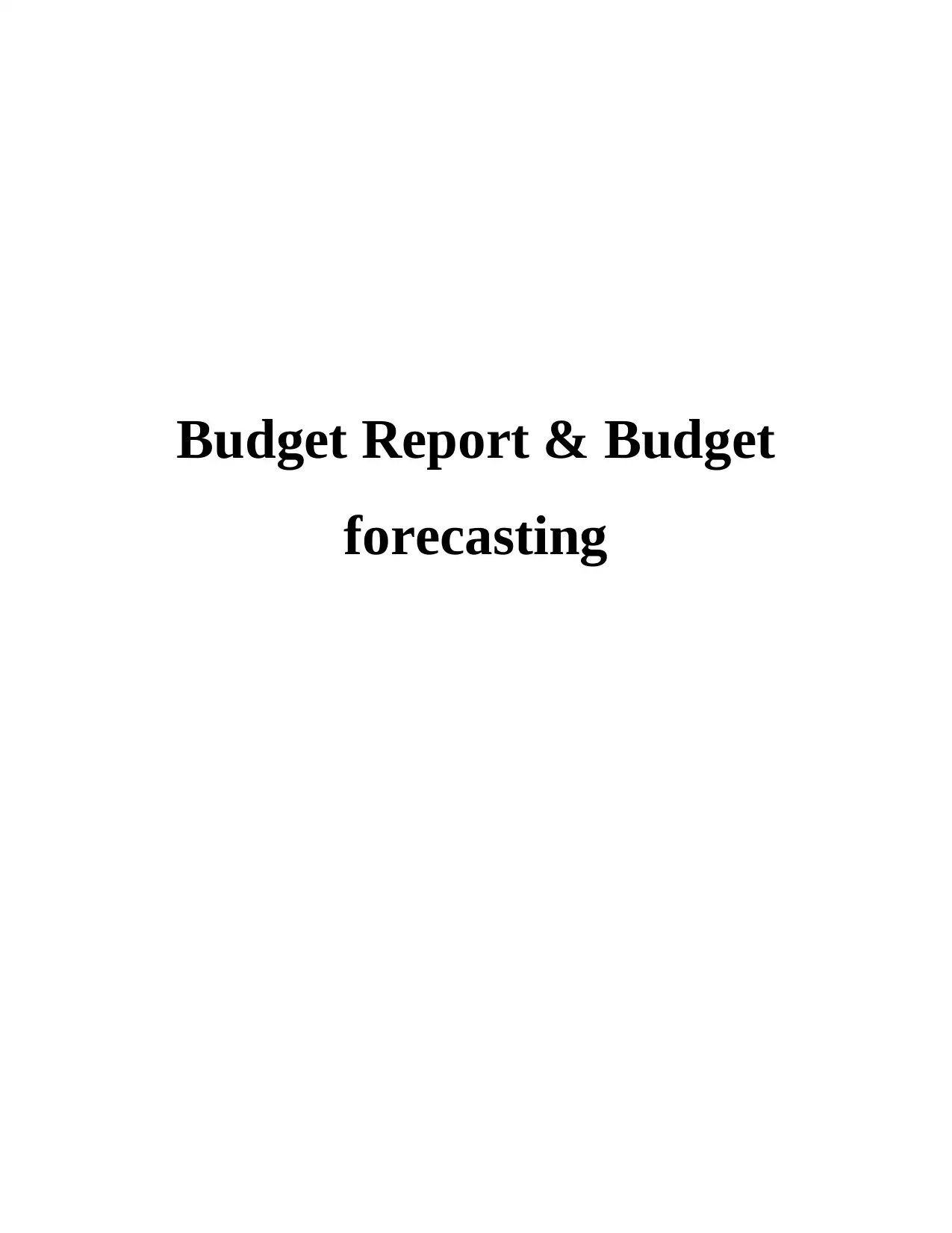
Budget Report & Budget
forecasting
forecasting
Paraphrase This Document
Need a fresh take? Get an instant paraphrase of this document with our AI Paraphraser
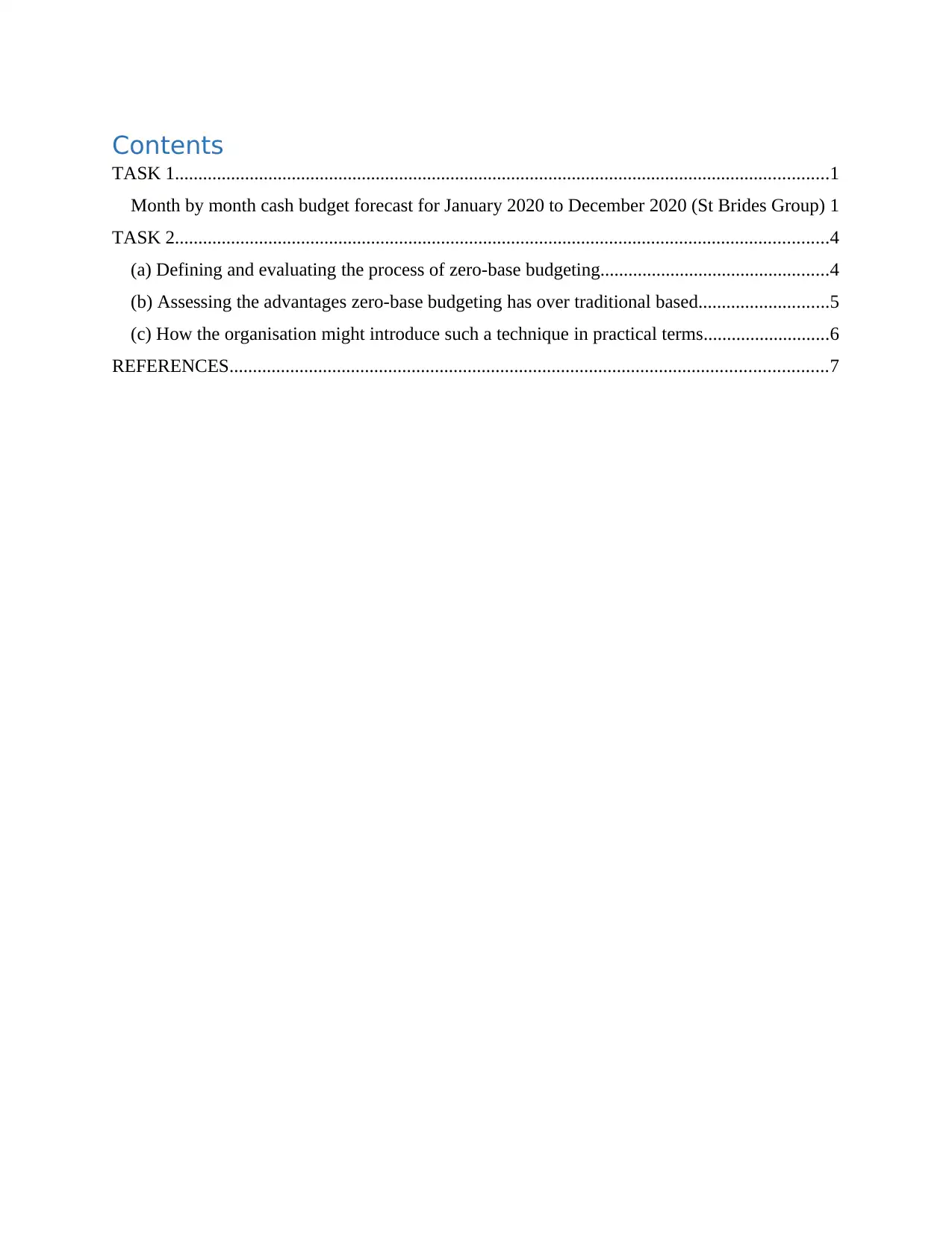
Contents
TASK 1............................................................................................................................................1
Month by month cash budget forecast for January 2020 to December 2020 (St Brides Group) 1
TASK 2............................................................................................................................................4
(a) Defining and evaluating the process of zero-base budgeting.................................................4
(b) Assessing the advantages zero-base budgeting has over traditional based............................5
(c) How the organisation might introduce such a technique in practical terms...........................6
REFERENCES................................................................................................................................7
TASK 1............................................................................................................................................1
Month by month cash budget forecast for January 2020 to December 2020 (St Brides Group) 1
TASK 2............................................................................................................................................4
(a) Defining and evaluating the process of zero-base budgeting.................................................4
(b) Assessing the advantages zero-base budgeting has over traditional based............................5
(c) How the organisation might introduce such a technique in practical terms...........................6
REFERENCES................................................................................................................................7
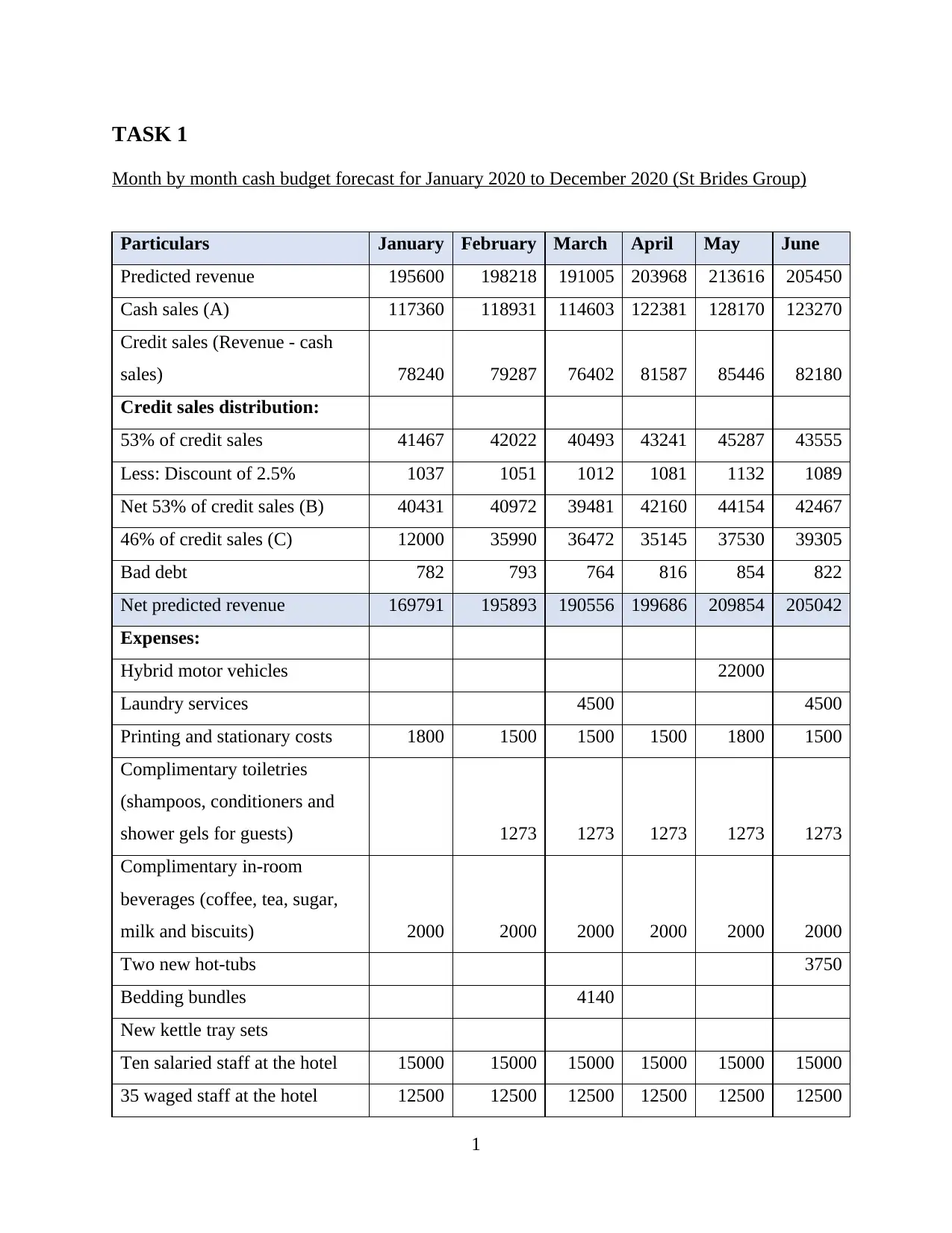
TASK 1
Month by month cash budget forecast for January 2020 to December 2020 (St Brides Group)
Particulars January February March April May June
Predicted revenue 195600 198218 191005 203968 213616 205450
Cash sales (A) 117360 118931 114603 122381 128170 123270
Credit sales (Revenue - cash
sales) 78240 79287 76402 81587 85446 82180
Credit sales distribution:
53% of credit sales 41467 42022 40493 43241 45287 43555
Less: Discount of 2.5% 1037 1051 1012 1081 1132 1089
Net 53% of credit sales (B) 40431 40972 39481 42160 44154 42467
46% of credit sales (C) 12000 35990 36472 35145 37530 39305
Bad debt 782 793 764 816 854 822
Net predicted revenue 169791 195893 190556 199686 209854 205042
Expenses:
Hybrid motor vehicles 22000
Laundry services 4500 4500
Printing and stationary costs 1800 1500 1500 1500 1800 1500
Complimentary toiletries
(shampoos, conditioners and
shower gels for guests) 1273 1273 1273 1273 1273
Complimentary in-room
beverages (coffee, tea, sugar,
milk and biscuits) 2000 2000 2000 2000 2000 2000
Two new hot-tubs 3750
Bedding bundles 4140
New kettle tray sets
Ten salaried staff at the hotel 15000 15000 15000 15000 15000 15000
35 waged staff at the hotel 12500 12500 12500 12500 12500 12500
1
Month by month cash budget forecast for January 2020 to December 2020 (St Brides Group)
Particulars January February March April May June
Predicted revenue 195600 198218 191005 203968 213616 205450
Cash sales (A) 117360 118931 114603 122381 128170 123270
Credit sales (Revenue - cash
sales) 78240 79287 76402 81587 85446 82180
Credit sales distribution:
53% of credit sales 41467 42022 40493 43241 45287 43555
Less: Discount of 2.5% 1037 1051 1012 1081 1132 1089
Net 53% of credit sales (B) 40431 40972 39481 42160 44154 42467
46% of credit sales (C) 12000 35990 36472 35145 37530 39305
Bad debt 782 793 764 816 854 822
Net predicted revenue 169791 195893 190556 199686 209854 205042
Expenses:
Hybrid motor vehicles 22000
Laundry services 4500 4500
Printing and stationary costs 1800 1500 1500 1500 1800 1500
Complimentary toiletries
(shampoos, conditioners and
shower gels for guests) 1273 1273 1273 1273 1273
Complimentary in-room
beverages (coffee, tea, sugar,
milk and biscuits) 2000 2000 2000 2000 2000 2000
Two new hot-tubs 3750
Bedding bundles 4140
New kettle tray sets
Ten salaried staff at the hotel 15000 15000 15000 15000 15000 15000
35 waged staff at the hotel 12500 12500 12500 12500 12500 12500
1
⊘ This is a preview!⊘
Do you want full access?
Subscribe today to unlock all pages.

Trusted by 1+ million students worldwide
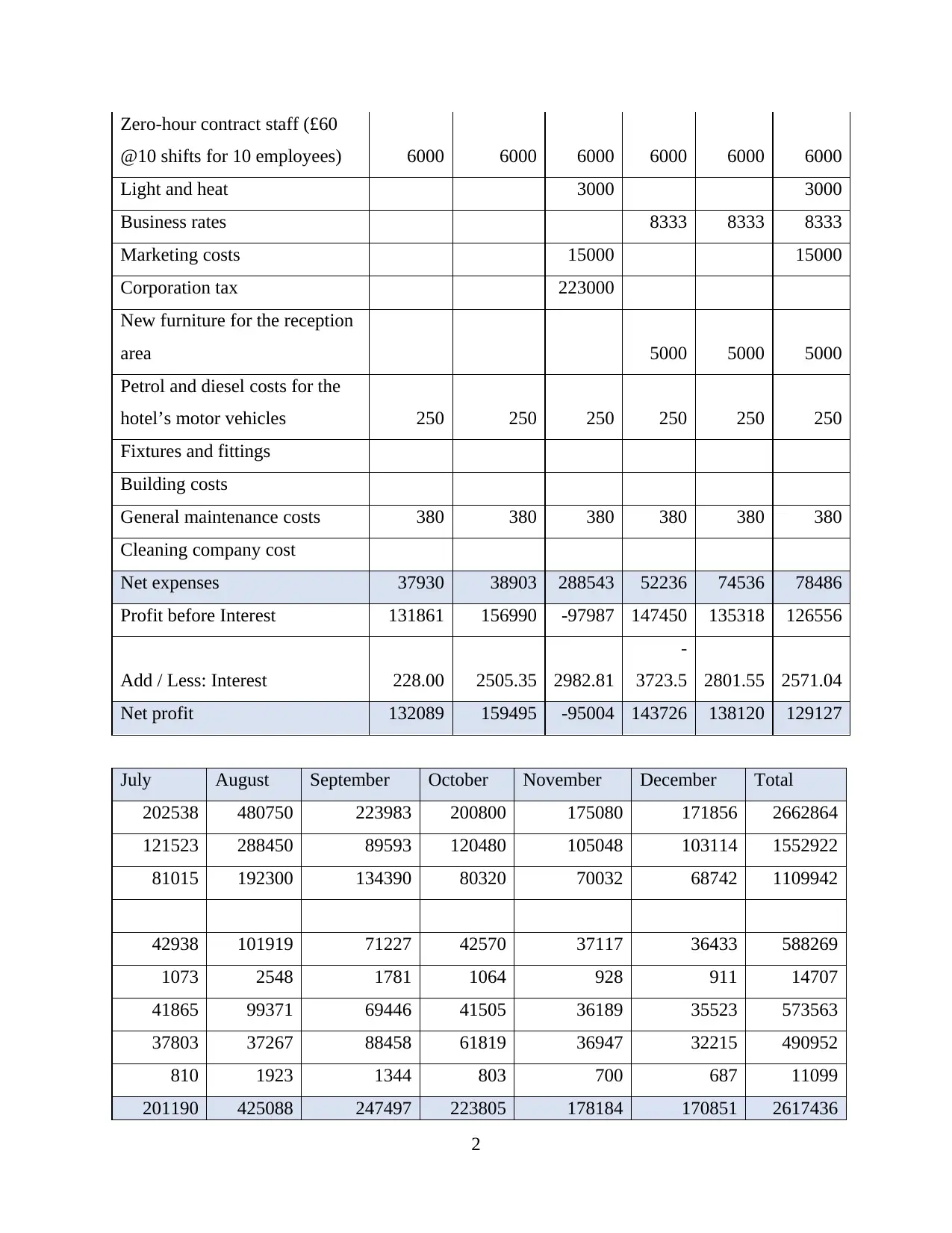
Zero-hour contract staff (£60
@10 shifts for 10 employees) 6000 6000 6000 6000 6000 6000
Light and heat 3000 3000
Business rates 8333 8333 8333
Marketing costs 15000 15000
Corporation tax 223000
New furniture for the reception
area 5000 5000 5000
Petrol and diesel costs for the
hotel’s motor vehicles 250 250 250 250 250 250
Fixtures and fittings
Building costs
General maintenance costs 380 380 380 380 380 380
Cleaning company cost
Net expenses 37930 38903 288543 52236 74536 78486
Profit before Interest 131861 156990 -97987 147450 135318 126556
Add / Less: Interest 228.00 2505.35 2982.81
-
3723.5 2801.55 2571.04
Net profit 132089 159495 -95004 143726 138120 129127
July August September October November December Total
202538 480750 223983 200800 175080 171856 2662864
121523 288450 89593 120480 105048 103114 1552922
81015 192300 134390 80320 70032 68742 1109942
42938 101919 71227 42570 37117 36433 588269
1073 2548 1781 1064 928 911 14707
41865 99371 69446 41505 36189 35523 573563
37803 37267 88458 61819 36947 32215 490952
810 1923 1344 803 700 687 11099
201190 425088 247497 223805 178184 170851 2617436
2
@10 shifts for 10 employees) 6000 6000 6000 6000 6000 6000
Light and heat 3000 3000
Business rates 8333 8333 8333
Marketing costs 15000 15000
Corporation tax 223000
New furniture for the reception
area 5000 5000 5000
Petrol and diesel costs for the
hotel’s motor vehicles 250 250 250 250 250 250
Fixtures and fittings
Building costs
General maintenance costs 380 380 380 380 380 380
Cleaning company cost
Net expenses 37930 38903 288543 52236 74536 78486
Profit before Interest 131861 156990 -97987 147450 135318 126556
Add / Less: Interest 228.00 2505.35 2982.81
-
3723.5 2801.55 2571.04
Net profit 132089 159495 -95004 143726 138120 129127
July August September October November December Total
202538 480750 223983 200800 175080 171856 2662864
121523 288450 89593 120480 105048 103114 1552922
81015 192300 134390 80320 70032 68742 1109942
42938 101919 71227 42570 37117 36433 588269
1073 2548 1781 1064 928 911 14707
41865 99371 69446 41505 36189 35523 573563
37803 37267 88458 61819 36947 32215 490952
810 1923 1344 803 700 687 11099
201190 425088 247497 223805 178184 170851 2617436
2
Paraphrase This Document
Need a fresh take? Get an instant paraphrase of this document with our AI Paraphraser
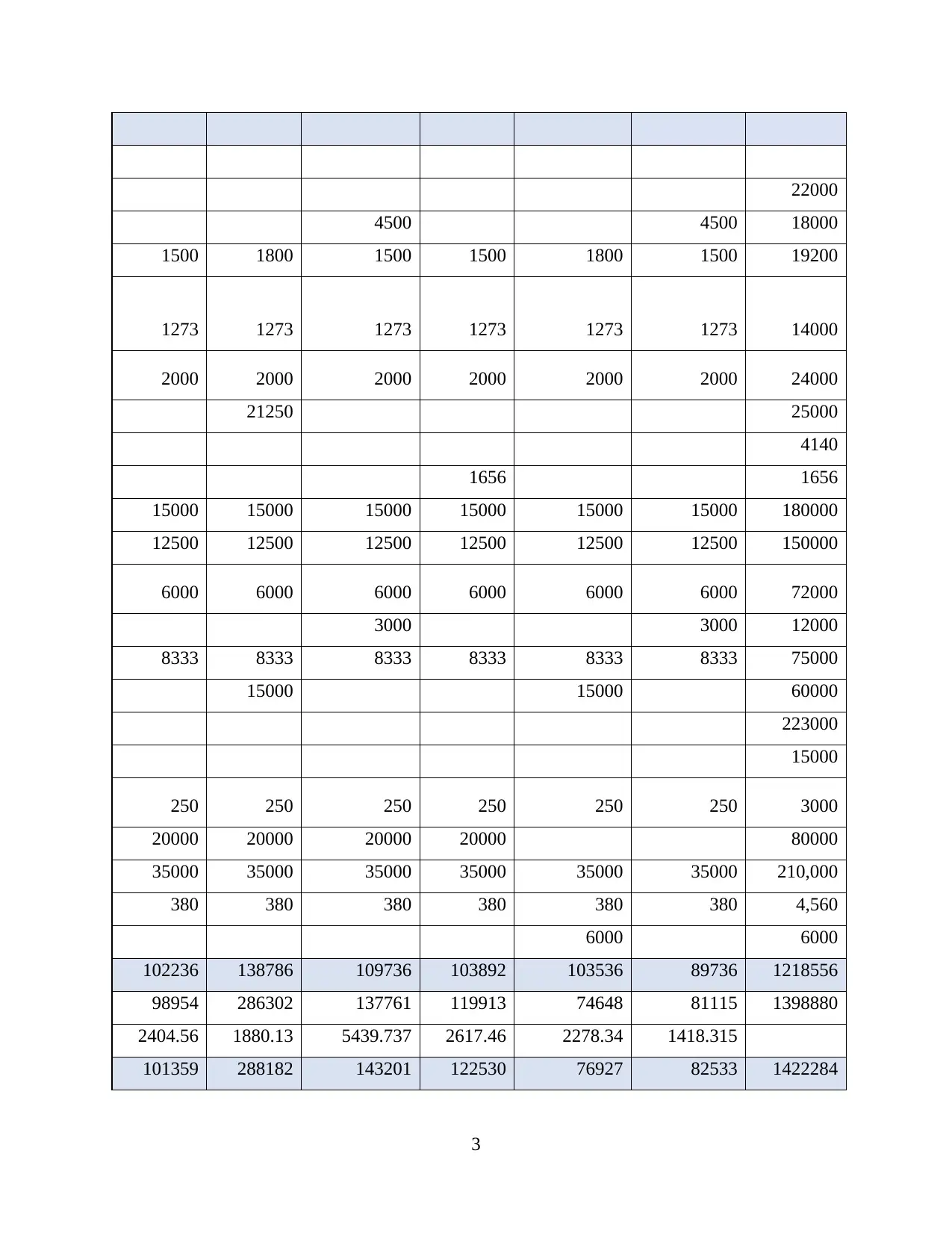
22000
4500 4500 18000
1500 1800 1500 1500 1800 1500 19200
1273 1273 1273 1273 1273 1273 14000
2000 2000 2000 2000 2000 2000 24000
21250 25000
4140
1656 1656
15000 15000 15000 15000 15000 15000 180000
12500 12500 12500 12500 12500 12500 150000
6000 6000 6000 6000 6000 6000 72000
3000 3000 12000
8333 8333 8333 8333 8333 8333 75000
15000 15000 60000
223000
15000
250 250 250 250 250 250 3000
20000 20000 20000 20000 80000
35000 35000 35000 35000 35000 35000 210,000
380 380 380 380 380 380 4,560
6000 6000
102236 138786 109736 103892 103536 89736 1218556
98954 286302 137761 119913 74648 81115 1398880
2404.56 1880.13 5439.737 2617.46 2278.34 1418.315
101359 288182 143201 122530 76927 82533 1422284
3
4500 4500 18000
1500 1800 1500 1500 1800 1500 19200
1273 1273 1273 1273 1273 1273 14000
2000 2000 2000 2000 2000 2000 24000
21250 25000
4140
1656 1656
15000 15000 15000 15000 15000 15000 180000
12500 12500 12500 12500 12500 12500 150000
6000 6000 6000 6000 6000 6000 72000
3000 3000 12000
8333 8333 8333 8333 8333 8333 75000
15000 15000 60000
223000
15000
250 250 250 250 250 250 3000
20000 20000 20000 20000 80000
35000 35000 35000 35000 35000 35000 210,000
380 380 380 380 380 380 4,560
6000 6000
102236 138786 109736 103892 103536 89736 1218556
98954 286302 137761 119913 74648 81115 1398880
2404.56 1880.13 5439.737 2617.46 2278.34 1418.315
101359 288182 143201 122530 76927 82533 1422284
3
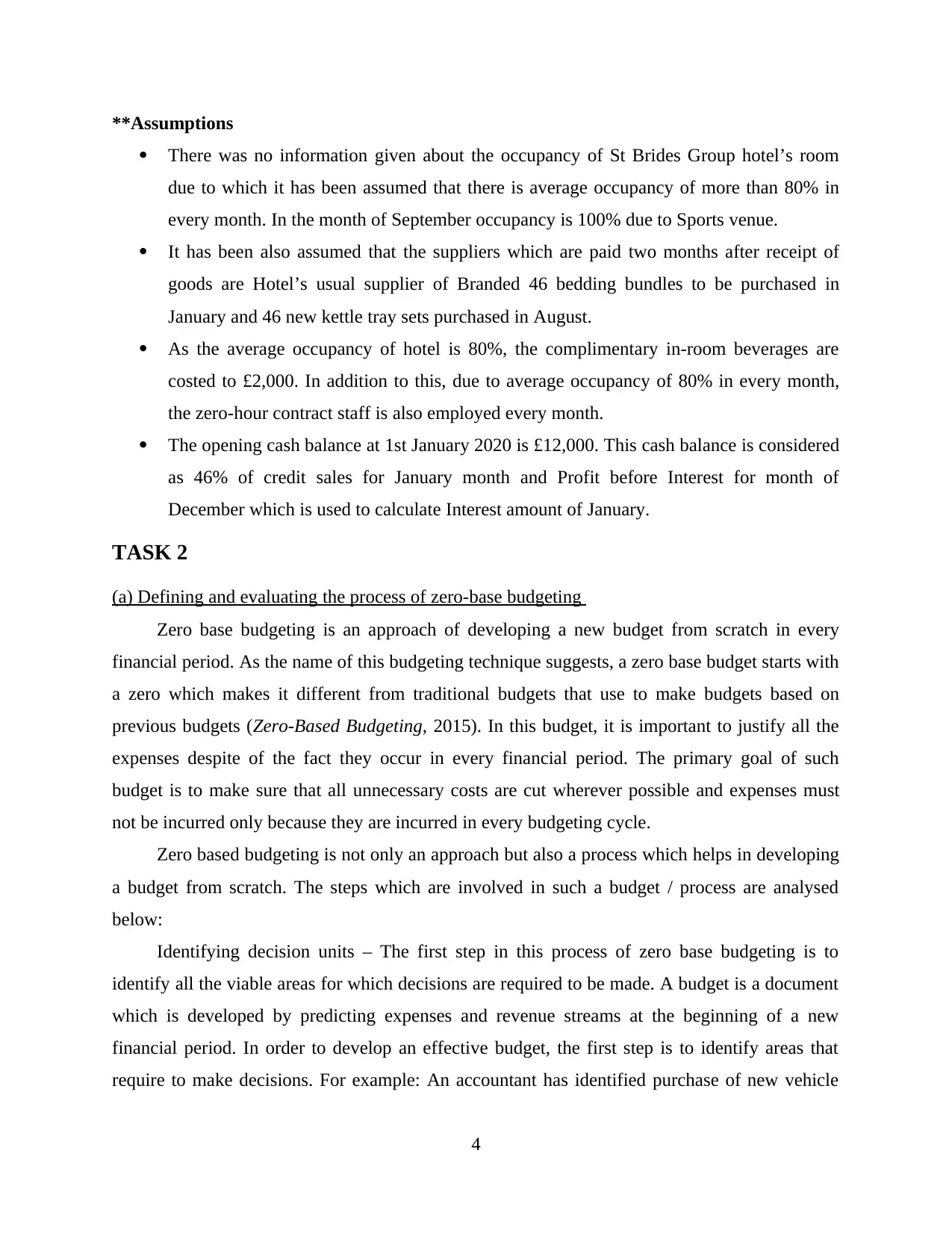
**Assumptions
There was no information given about the occupancy of St Brides Group hotel’s room
due to which it has been assumed that there is average occupancy of more than 80% in
every month. In the month of September occupancy is 100% due to Sports venue.
It has been also assumed that the suppliers which are paid two months after receipt of
goods are Hotel’s usual supplier of Branded 46 bedding bundles to be purchased in
January and 46 new kettle tray sets purchased in August.
As the average occupancy of hotel is 80%, the complimentary in-room beverages are
costed to £2,000. In addition to this, due to average occupancy of 80% in every month,
the zero-hour contract staff is also employed every month.
The opening cash balance at 1st January 2020 is £12,000. This cash balance is considered
as 46% of credit sales for January month and Profit before Interest for month of
December which is used to calculate Interest amount of January.
TASK 2
(a) Defining and evaluating the process of zero-base budgeting
Zero base budgeting is an approach of developing a new budget from scratch in every
financial period. As the name of this budgeting technique suggests, a zero base budget starts with
a zero which makes it different from traditional budgets that use to make budgets based on
previous budgets (Zero-Based Budgeting, 2015). In this budget, it is important to justify all the
expenses despite of the fact they occur in every financial period. The primary goal of such
budget is to make sure that all unnecessary costs are cut wherever possible and expenses must
not be incurred only because they are incurred in every budgeting cycle.
Zero based budgeting is not only an approach but also a process which helps in developing
a budget from scratch. The steps which are involved in such a budget / process are analysed
below:
Identifying decision units – The first step in this process of zero base budgeting is to
identify all the viable areas for which decisions are required to be made. A budget is a document
which is developed by predicting expenses and revenue streams at the beginning of a new
financial period. In order to develop an effective budget, the first step is to identify areas that
require to make decisions. For example: An accountant has identified purchase of new vehicle
4
There was no information given about the occupancy of St Brides Group hotel’s room
due to which it has been assumed that there is average occupancy of more than 80% in
every month. In the month of September occupancy is 100% due to Sports venue.
It has been also assumed that the suppliers which are paid two months after receipt of
goods are Hotel’s usual supplier of Branded 46 bedding bundles to be purchased in
January and 46 new kettle tray sets purchased in August.
As the average occupancy of hotel is 80%, the complimentary in-room beverages are
costed to £2,000. In addition to this, due to average occupancy of 80% in every month,
the zero-hour contract staff is also employed every month.
The opening cash balance at 1st January 2020 is £12,000. This cash balance is considered
as 46% of credit sales for January month and Profit before Interest for month of
December which is used to calculate Interest amount of January.
TASK 2
(a) Defining and evaluating the process of zero-base budgeting
Zero base budgeting is an approach of developing a new budget from scratch in every
financial period. As the name of this budgeting technique suggests, a zero base budget starts with
a zero which makes it different from traditional budgets that use to make budgets based on
previous budgets (Zero-Based Budgeting, 2015). In this budget, it is important to justify all the
expenses despite of the fact they occur in every financial period. The primary goal of such
budget is to make sure that all unnecessary costs are cut wherever possible and expenses must
not be incurred only because they are incurred in every budgeting cycle.
Zero based budgeting is not only an approach but also a process which helps in developing
a budget from scratch. The steps which are involved in such a budget / process are analysed
below:
Identifying decision units – The first step in this process of zero base budgeting is to
identify all the viable areas for which decisions are required to be made. A budget is a document
which is developed by predicting expenses and revenue streams at the beginning of a new
financial period. In order to develop an effective budget, the first step is to identify areas that
require to make decisions. For example: An accountant has identified purchase of new vehicle
4
⊘ This is a preview!⊘
Do you want full access?
Subscribe today to unlock all pages.

Trusted by 1+ million students worldwide
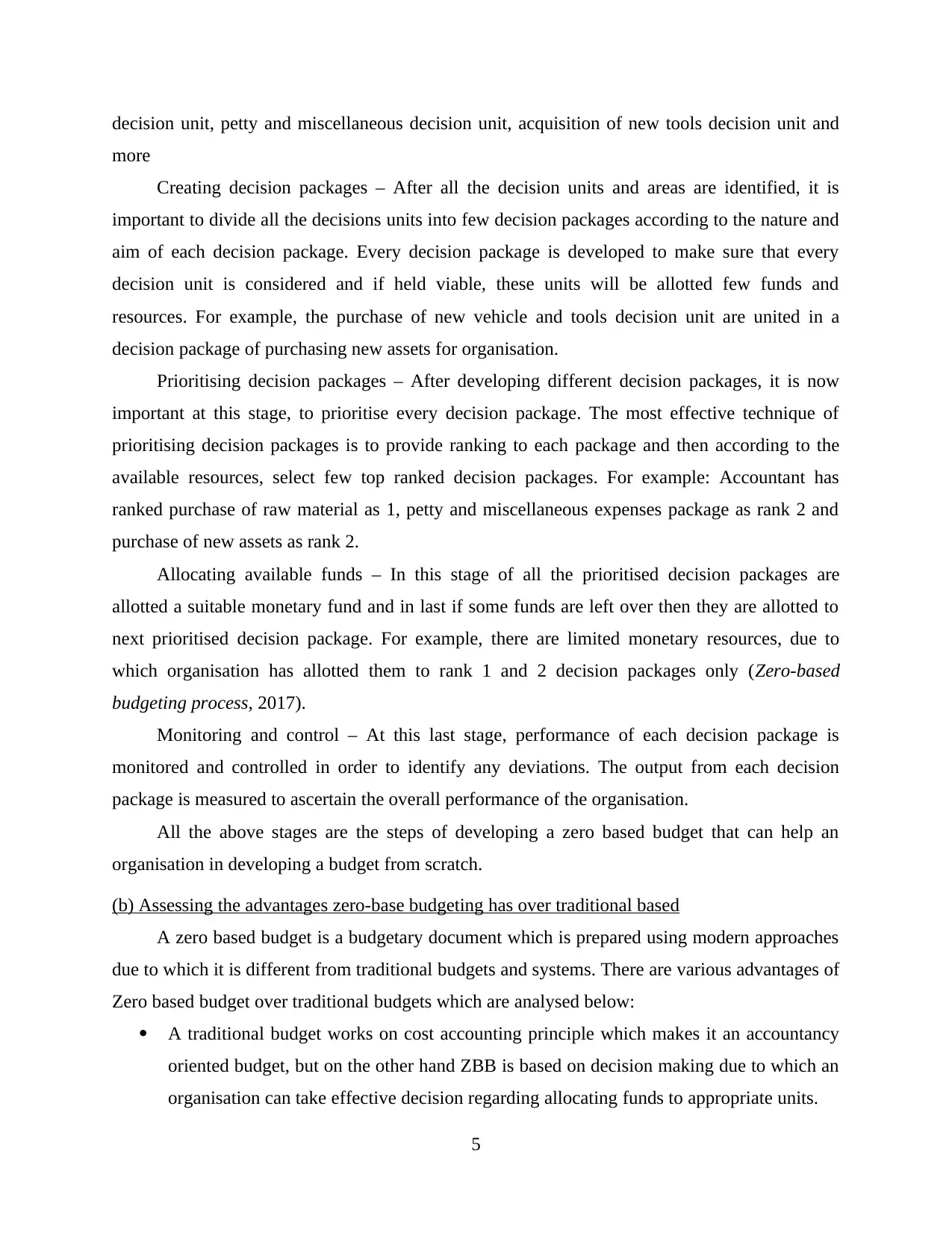
decision unit, petty and miscellaneous decision unit, acquisition of new tools decision unit and
more
Creating decision packages – After all the decision units and areas are identified, it is
important to divide all the decisions units into few decision packages according to the nature and
aim of each decision package. Every decision package is developed to make sure that every
decision unit is considered and if held viable, these units will be allotted few funds and
resources. For example, the purchase of new vehicle and tools decision unit are united in a
decision package of purchasing new assets for organisation.
Prioritising decision packages – After developing different decision packages, it is now
important at this stage, to prioritise every decision package. The most effective technique of
prioritising decision packages is to provide ranking to each package and then according to the
available resources, select few top ranked decision packages. For example: Accountant has
ranked purchase of raw material as 1, petty and miscellaneous expenses package as rank 2 and
purchase of new assets as rank 2.
Allocating available funds – In this stage of all the prioritised decision packages are
allotted a suitable monetary fund and in last if some funds are left over then they are allotted to
next prioritised decision package. For example, there are limited monetary resources, due to
which organisation has allotted them to rank 1 and 2 decision packages only (Zero-based
budgeting process, 2017).
Monitoring and control – At this last stage, performance of each decision package is
monitored and controlled in order to identify any deviations. The output from each decision
package is measured to ascertain the overall performance of the organisation.
All the above stages are the steps of developing a zero based budget that can help an
organisation in developing a budget from scratch.
(b) Assessing the advantages zero-base budgeting has over traditional based
A zero based budget is a budgetary document which is prepared using modern approaches
due to which it is different from traditional budgets and systems. There are various advantages of
Zero based budget over traditional budgets which are analysed below:
A traditional budget works on cost accounting principle which makes it an accountancy
oriented budget, but on the other hand ZBB is based on decision making due to which an
organisation can take effective decision regarding allocating funds to appropriate units.
5
more
Creating decision packages – After all the decision units and areas are identified, it is
important to divide all the decisions units into few decision packages according to the nature and
aim of each decision package. Every decision package is developed to make sure that every
decision unit is considered and if held viable, these units will be allotted few funds and
resources. For example, the purchase of new vehicle and tools decision unit are united in a
decision package of purchasing new assets for organisation.
Prioritising decision packages – After developing different decision packages, it is now
important at this stage, to prioritise every decision package. The most effective technique of
prioritising decision packages is to provide ranking to each package and then according to the
available resources, select few top ranked decision packages. For example: Accountant has
ranked purchase of raw material as 1, petty and miscellaneous expenses package as rank 2 and
purchase of new assets as rank 2.
Allocating available funds – In this stage of all the prioritised decision packages are
allotted a suitable monetary fund and in last if some funds are left over then they are allotted to
next prioritised decision package. For example, there are limited monetary resources, due to
which organisation has allotted them to rank 1 and 2 decision packages only (Zero-based
budgeting process, 2017).
Monitoring and control – At this last stage, performance of each decision package is
monitored and controlled in order to identify any deviations. The output from each decision
package is measured to ascertain the overall performance of the organisation.
All the above stages are the steps of developing a zero based budget that can help an
organisation in developing a budget from scratch.
(b) Assessing the advantages zero-base budgeting has over traditional based
A zero based budget is a budgetary document which is prepared using modern approaches
due to which it is different from traditional budgets and systems. There are various advantages of
Zero based budget over traditional budgets which are analysed below:
A traditional budget works on cost accounting principle which makes it an accountancy
oriented budget, but on the other hand ZBB is based on decision making due to which an
organisation can take effective decision regarding allocating funds to appropriate units.
5
Paraphrase This Document
Need a fresh take? Get an instant paraphrase of this document with our AI Paraphraser

According to the traditional budgeting, every departmental unit is provided with a
suitable budget that is allotted to these units every year. Such budget encourages
departments to spent even if the spending is not necessary. When a fund is allotted to
each department they spend it as if they don’t, they will lose their funds. This deviation in
this approach is bridged under zero based budgeting as a ZBB do not allocate same funds
every year as these budgets are developed from scratch every year and are not related
with last year (Traditional Budgeting Vs. Zero Base Budgeting, 2020).
Another advantage of ZBB over traditional budgeting is accuracy. In the method of ZBB,
budgets are developed from a zero level every year due to which if there are any arbitrary
changes are included from last year, they are eliminated in current year’s budget which
reduces overall expenditure of the organisation.
(c) How the organisation might introduce such a technique in practical terms
There are various benefits of zero based budgeting but developing such a budget is a
complex task due to which organisations avoid to adopt approach of zero based budgeting. There
are various ways by which an organisation can introduce ZBB in practical terms:
An organisation can hire a professional so that the complex task of developing a ZBB can be
done.
Another way of introducing ZBB is to identify each and every decision unit in the
organisation which requires funds. Under this way, all decisions units will be identified and
organisation will know that to a what extend they require monetary resources.
An organisation can introduce ZBB by making clear objectives for their operations and
future revenues so that the budget will consider those aims and according will prioritize each
decision unit or a decision package.
Developing a budget is a task for accountants but developing a zero based budget requires
strategic decisions due to which managers of an organisation can first set out their business
strategies which will provide a base to develop zero based budget (Ways to use Zero-based
budgeting, 2020).
6
suitable budget that is allotted to these units every year. Such budget encourages
departments to spent even if the spending is not necessary. When a fund is allotted to
each department they spend it as if they don’t, they will lose their funds. This deviation in
this approach is bridged under zero based budgeting as a ZBB do not allocate same funds
every year as these budgets are developed from scratch every year and are not related
with last year (Traditional Budgeting Vs. Zero Base Budgeting, 2020).
Another advantage of ZBB over traditional budgeting is accuracy. In the method of ZBB,
budgets are developed from a zero level every year due to which if there are any arbitrary
changes are included from last year, they are eliminated in current year’s budget which
reduces overall expenditure of the organisation.
(c) How the organisation might introduce such a technique in practical terms
There are various benefits of zero based budgeting but developing such a budget is a
complex task due to which organisations avoid to adopt approach of zero based budgeting. There
are various ways by which an organisation can introduce ZBB in practical terms:
An organisation can hire a professional so that the complex task of developing a ZBB can be
done.
Another way of introducing ZBB is to identify each and every decision unit in the
organisation which requires funds. Under this way, all decisions units will be identified and
organisation will know that to a what extend they require monetary resources.
An organisation can introduce ZBB by making clear objectives for their operations and
future revenues so that the budget will consider those aims and according will prioritize each
decision unit or a decision package.
Developing a budget is a task for accountants but developing a zero based budget requires
strategic decisions due to which managers of an organisation can first set out their business
strategies which will provide a base to develop zero based budget (Ways to use Zero-based
budgeting, 2020).
6
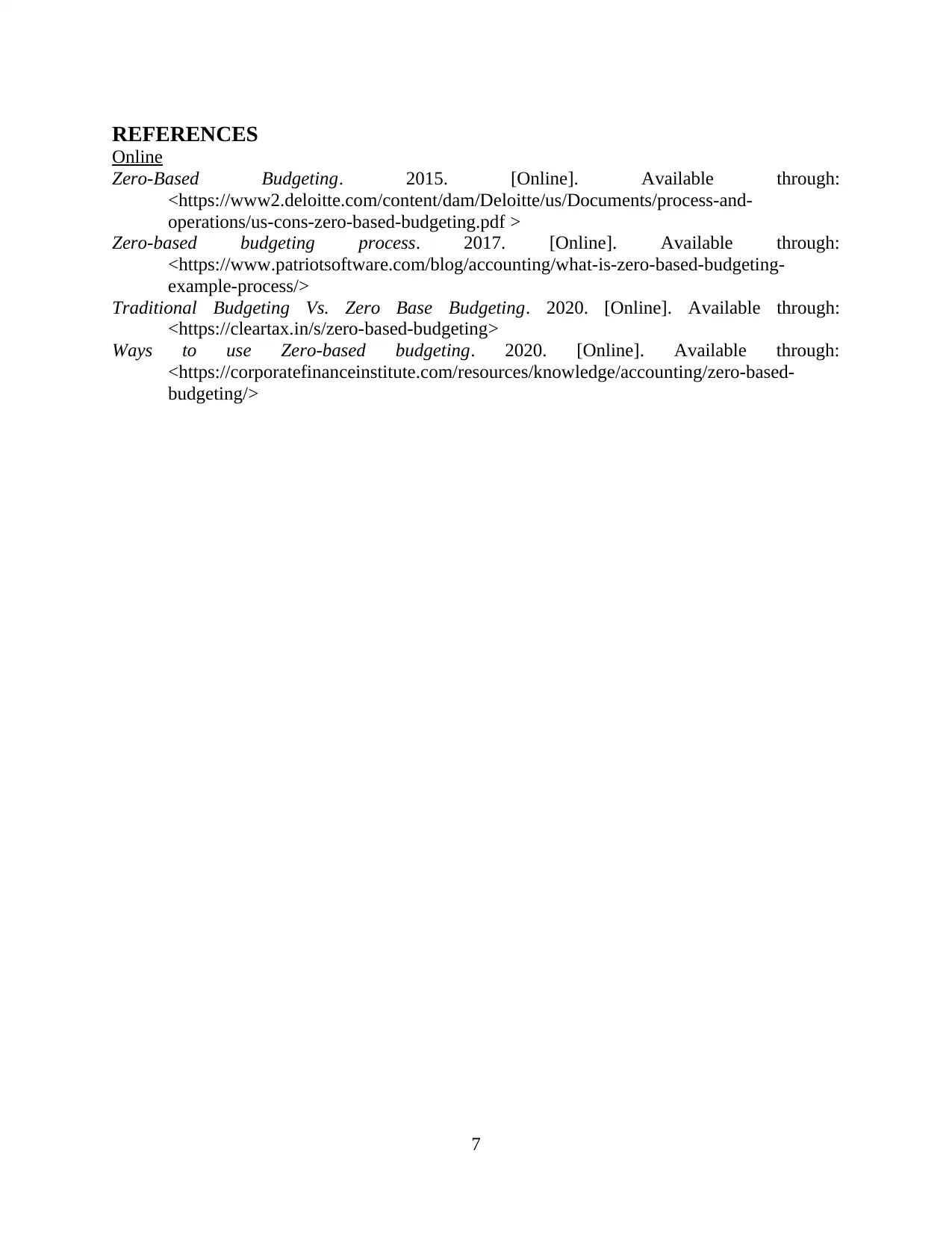
REFERENCES
Online
Zero-Based Budgeting. 2015. [Online]. Available through:
<https://www2.deloitte.com/content/dam/Deloitte/us/Documents/process-and-
operations/us-cons-zero-based-budgeting.pdf >
Zero-based budgeting process. 2017. [Online]. Available through:
<https://www.patriotsoftware.com/blog/accounting/what-is-zero-based-budgeting-
example-process/>
Traditional Budgeting Vs. Zero Base Budgeting. 2020. [Online]. Available through:
<https://cleartax.in/s/zero-based-budgeting>
Ways to use Zero-based budgeting. 2020. [Online]. Available through:
<https://corporatefinanceinstitute.com/resources/knowledge/accounting/zero-based-
budgeting/>
7
Online
Zero-Based Budgeting. 2015. [Online]. Available through:
<https://www2.deloitte.com/content/dam/Deloitte/us/Documents/process-and-
operations/us-cons-zero-based-budgeting.pdf >
Zero-based budgeting process. 2017. [Online]. Available through:
<https://www.patriotsoftware.com/blog/accounting/what-is-zero-based-budgeting-
example-process/>
Traditional Budgeting Vs. Zero Base Budgeting. 2020. [Online]. Available through:
<https://cleartax.in/s/zero-based-budgeting>
Ways to use Zero-based budgeting. 2020. [Online]. Available through:
<https://corporatefinanceinstitute.com/resources/knowledge/accounting/zero-based-
budgeting/>
7
⊘ This is a preview!⊘
Do you want full access?
Subscribe today to unlock all pages.

Trusted by 1+ million students worldwide
1 out of 9
Your All-in-One AI-Powered Toolkit for Academic Success.
+13062052269
info@desklib.com
Available 24*7 on WhatsApp / Email
![[object Object]](/_next/static/media/star-bottom.7253800d.svg)
Unlock your academic potential
© 2024 | Zucol Services PVT LTD | All rights reserved.


